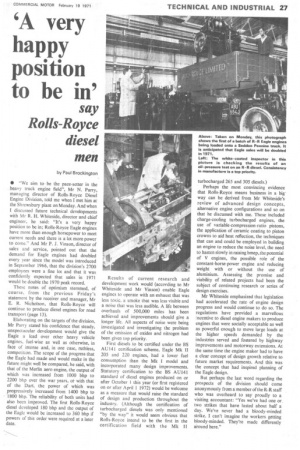'A very happy position to be in'
Page 29

If you've noticed an error in this article please click here to report it so we can fix it.
say Rolls-Royce diesel men
by Paul Brockington • "We aim to be the pace-setter in the heavy truck engine field", Mr N. Parry, managing director of Rolls-Royce Diesel Engine Division, told me when I met him at the Shrewsbury plant on Monday. And when I discussed future technical developments with Mr R. H. Whiteside, director and chief engineer, he said: "It's a very happy position to be in; Rolls-Royce Eagle engines have more than enough horsepower to meet current needs and there is a lot more power to come." And Mr P. J. Vinson, director of sales and service, pointed out that the demand for Eagle engines had doubled every year since the model was introduced in September 1966, that the division's 2700 employees were a fine lot and that it was confidently expected that sales in 1971 would be double the 1970 peak record.
These notes of optimism stemmed, of course, from the previous Friday's statement by the receiver and manager, Mr E. R. Nicholson, that Rolls-Royce will continue to produce diesel engines for road transport (page 13).
Elaborating on the targets of the division, Mr Parry stated his confidence that steady, unspectacular development would give the Eagle a lead over other heavy vehicle engines, fuel-wise as well as otherwise, in face of intense and, in one case, ruthless, competition. The scope of the progress that the Eagle had made and would make in the future might well be compared, he said, with that of the Merlin aero engine, the output of which was increased from 1000 bhp to 2200 bhp over the war years, or with that of the Dart, the power of which was progressively increased from 1400 bhp to 1800 bhp. The reliability of both units had also been improved. The first Rolls-Royce diesel developed 180 bhp and the output of the Eagle would be increased to 360 bhp if powers of this order were required at a later date. Results of current research and development work would (according to Mr Whiteside and Mr Vinson) enable Eagle engines to operate with an exhaust that was less toxic, a smoke that was less visible and a noise that was less audible. A life between overhauls of 500,000 miles has been achieved and improvements should give a longer life. All aspects of noise were being investigated and investigating the problem of the emission of oxides and nitrogen had been given top priority.
First diesels to be certified under the BS AU141 certification scheme, Eagle Mk 11 205 and 220 engines, had a lower fuel consumption than the Mk I model and incorporated many design improvements. Statutory certification to the BS AU141 standard of diesel engines produced on or after October 1 this year (or first registered on or after April 11972) would be welcome as a measure that would raise the standard of design and production throughout the industry. (Although the certification of turbocharged diesels was only mentioned "by the way" it would seem obvious that Rolls-Royce intend to be the first in the certification field with the Mk II turbocharged 265 and 305 diesels.) Perhaps the most convincing evidence that Rolls-Royce means business in a big' way can be derived from Mr Whiteside's review of advanced design concepts, alternative engine configurations and so on that he discussed with me. These included charge-cooling turbocharged engines, the use of variable-compression-ratio pistons, the application of ceramic coating to piston crowns to aid heat reflection, the techniques that can and could be employed in building an engine to reduce the noise level, the need to hasten slowly in raising bmep, the potential of V engines, the possible role of the constant-horse-power engine and reducing weight with or without the use of aluminium. Assessing the promise and viability of related projects had been the subject of continuing research or series of design exercises.
Mr Whiteside emphasized that legislation had accelerated the rate of engine design progress and would continue to do so. The regulations have provided a marvellous incentive to diesel engine makers to produce engines that were socially acceptable as well as powerful enough to move large loads at the higher speeds demanded by the industries served and fostered by highway improvements and motorway extensions. At the same time the engine maker had to have a clear concept of design growth relative to future market requirements. And this was the concept that had inspired planning of the Eagle design.
But perhaps the last word regarding the prospects of the division should come anonymously from a member of the R-R staff who was overheard to say proudly to a visiting accountant: "Yes we've had one or two strikes that have lasted about half a day. We've never had a bloody-minded strike. I can't imagine the workers getting bloody-minded. They're made differently around here."





























